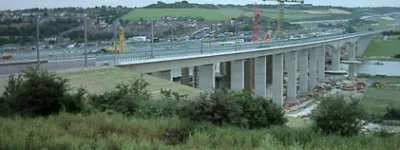Blackpool needs a direct motorway connection to the M6 and the wider world, and the M55 is here to do the job.
It begins to the north of Preston and runs to the outskirts of Blackpool where traffic is dispersed onto a number of smaller approach roads. Its official name is the Preston Northern Bypass.
During the summer, it's often thick with traffic, and accounts for about half of the traffic load of the M6 around Preston. In winter months it tends to be noticeably quieter. Even so, Blackpool and Preston are large urban centres in their own right, and the motorway remains reasonably well used all through the year.
For almost half a century there was no junction 2 on the M55, since it had been reserved for a future Preston Western Bypass. First proposed in the 1950s, the idea was that the M6 would form one side of a complete box around the city. The plan reappeared in the 1980s, when the M65 was supposed to travel around the south and west of the city to meet the M55, but it was cancelled for good when the M6 Preston Bypass was widened to dual four-lanes instead.
Having been missing since 1975, junction 2 finally arrived in 2023 to serve Preston's new western distributor road, a new route that opens up land for new housing developments. As it stands this road is not a western bypass, since it doesn't cross the Ribble, though the number A582 suggests there is at least a hope of it one day joining up with the other part of the A582 which travels around the south side of Preston.
The M55 is perhaps the candidate for most unassuming bit of road to be a crucial part of British motoring history. The section of motorway from the M6 to M55 junction 1 was built as the northernmost part of the Preston Bypass, meaning that it was once Britain's first motorway.

